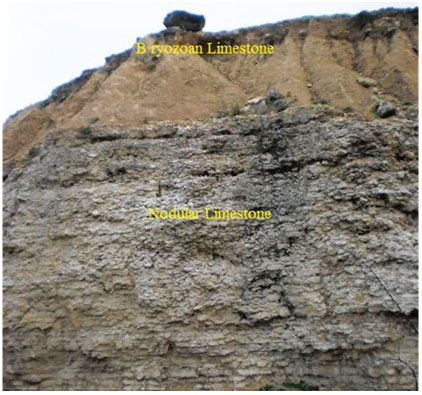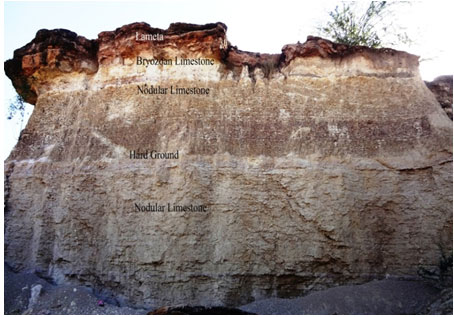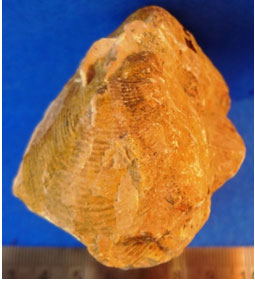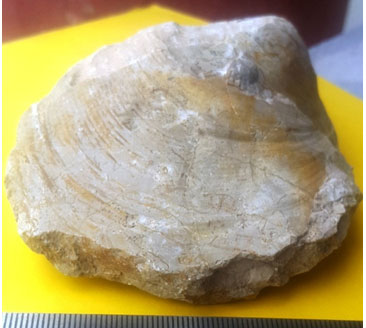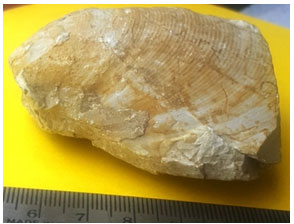1Department of Zoology, Mata Jijabai Goverment Post Gratuate Girls College, Moti Tabela, Indore MP India
2Department of Zoology, Tukojirao Pawar Goverment New Science College, Dewas MP India
Corresponding author email: amritakhatri53@gmail.com
Article Publishing History
Received: 12/12/2020
Accepted After Revision: 25/03/2021
The present paleo environmental study has been performed with respect to bivalve fossil assemblages, explored in and around Bagh at tehsil Kukshi and tehsil Manawar of district Dhar of Madhya Pradesh, India. In mollusca, Inoceramid bivalves dominate in Bagh beds, they are sessile benthos so, the study of paleoenvironment of the Bagh beds can be figured out from them, particularly their abundant diversity and number may be due to the variation in the sea level and other oceanographic conditions. Their large number and varieties are found embedded in different levels of Nodular limestone. This study will help to reconstruct the idea about ecosystem of past time. The present approach is to step up paleoecology of excavated Inoceramid fossils of class bivalve of Cretaceous period obtained from different vicinities of Bagh beds of Dhar district. The collected specimens have been compared with previously collected specimens of bivalves from different parts of the world by many paleontologists to get more appropriate results.
The intense and passionate examination of morphology and systematic study of Inoceramid fossils was needed for paleoecological study. Three species viz. Inoceramus concentricus, Inoceramus concentricus var. baghensis and Inoceramus concentricus var. subsulcatus of bivalves were excavated, their paleontology have also been described in the present paper. These explored species were also studied systematically and paleoecologically. The study also deals about the mode of life and the environment in which they lived. Inoceramids are extinct bivalves but by homoplassic approach, it can be said that they were essentially sessile benthos and probably used their byssus for anchoring in high energy environment. In nature they are gregarious and independent of any sedimentary facies. They thrived on the shallow marine continental shelf as well as in estuarine conditions. They are cosmopolitan, may be due to their planktotrophic larval stage. The Bagh beds being a product of epicontinental Cretaceous sea, provide congenial environment for flourishing the Inoceramid bivalves.
Bagh beds, Cretaceous, Fossils, Inoceramid, Paleoecology.
Khatri A, Pathrade M. Paleoenvironmental Analysis of Cretaceous Inoceramid fossils of Bagh beds from Eastern Region of India. Biosc.Biotech.Res.Comm. 2021;14(1).
Khatri A, Pathrade M. Paleoenvironmental Analysis of Cretaceous Inoceramid fossils of Bagh beds from Eastern Region of India. Biosc.Biotech.Res.Comm. 2021;14(1). Available from: <a href=”https://bit.ly/3pK5M9L”>https://bit.ly/3pK5M9L</a>
Copyright © Khatri and Pathrade This is an open access article distributed under the terms of the Creative Commons Attribution License (CC-BY) https://creativecommns.org/licenses/by/4.0/, which permits unrestricted use distribution and reproduction in any medium, provide the original author and source are credited.
INTRODUCTION
Paleoenvironmental or paleoecology is the study of ecology in regards to fossil assemblages of the inhabitants, which lived in the past. It utilizes the details of collected fossils which can rebuild the ecosystems of the past. Eventually these studies may offer information on essential biological questions as the growth and reason of adaptive morphological alteration observed today with paleoenvironment. The Bagh bed is a noteworthy paleontological unit of the Narmada valley, which was formed by invading water of transgressing arm of Tethys Ocean. The name “Bagh beds” comes from the type locality Bagh. Many macro invertebrate fossil fauna exists in Bagh beds including bivalves. The Paleoecology of bivalves of Bagh beds during Cretaceous period has been focused in the present research, which is illustrated by assorted assemblage of bivalves excavated from these beds.Currently the deposit from Bagh beds is dispersed sporadically, which was spread about 345 km away from Barwah (M.P.), east to Rajpipla (Gujarat) in the west. The Bagh beds can be discriminated in Eastern region which comprises the region of Barwah (Man valley), Bagh in the Dhar district and is extended upto Jobat in the Alirajpur – Jhabua district of M.P and Western region which covers the area from west of Alirajpur (MP India), all the way through Kawant up to Rajpipla in Baruch district, Gujarat India
The Bagh beds comprise of Nimar Sandstones, Nodular Limestone and Bryozoan Limestone. They first appeared about 300 million years ago, in the middle Cambrian and were plentiful during the Mesozoic and Cenozoic eras, deep in the sea, ocean and streams. However, they were ample in the Silurian and Devonian period. One of the valuable biostratigraphic group of bivalves is Inoceramids,that disappeared at the end of the Cretaceous period. Inoceramids had a comparatively wide ecological tolerance at the genus and species level. This was more prominent group and abundant in quantity and diversity than any other group of bivalves in the study area. Inoceramid bivalves first existed in the Permian and became dominant during the Jurassic and Cretaceous period.
The Inoceramids are good bioindicators for considering the stratigraphy and age of rock formation. Kumar et al (2018) tried to solve confusion the age of the Nodular Limestone formation (Late Cretaceous) at sub stage level throughout ammonoid and Inoceramid index taxa. They also agreed to differentiate the three divisions (Early, Middle and Late) of the Turonian stage in the Narmada basin, Central India. Extensive Inoceramus fossil collection from late Cretaceous at Bagh beds has been done to construct lithological, biostratigraphic and chronostratigraphic framework. Even though among widespread information accessible concerning the entire fauna of the Bagh beds, it has become possible to interpret paleoecology with special reference to bivalves. Foremost involvement on invertebrate remnants of Bagh were studied by various paleontologists viz. Chiplonkar (1937-1942), Badve (1972), Ghare (1974), Dassarma and Sinha (1975), Nayak, (1983), Gangopadhyay & Bardhan (2007),Smith (2010), and Gangopadhyay & Maiti (2012), Pathrade et al. (2012), recently, Khatri and Pathrade (2016), and Kumar et al. (2018).
Further significant work on paleoecology on Bagh beds of Eastern Indian region has not been reported recently . In this part of research, the bivalve fossil fauna was collected and identified. They were then verified from Geological Survey of India” CHQ, Curatorial division, Kolkata, West Bengal. Many paleontologists worked on different aspects of paleontology, but work on paleoecology of bivalves (Inoceramids) of Bagh beds is very scanty, so this Paleoecological study of the collected bivalve fossil fauna has been explored to know their past environment. The objective was chosen to unknot the facts of their habitats and climate in the past.
MATERIAL AND METHODS
Location of the study AREA : The present paleontological research was performed in Dhar district of Madhya Pradesh. The most important outcrop of invertebrate fossils was noticed in and around Bagh of tehsil Kukshi and tehsil Manawar of district Dhar (Fig. 1, 2, and 3).
Figure 1: Inferredseawayalongthe Narmada–TaptiriftintheDeccanvolcanicProvince,peninsularIndia (after Keller etal.,2009).
Figure 2: Field Photograph: Bagh Beds exposed near Gandhwani village (Manawar)
Figure 3: Field Photograph: Bagh Beds exposed near Khandlai village ( Kukshi)
Survey of the fossiliferous areas in different villages has been done by land records. Stratigraphical and geological study of the fossiliferous rocks had also been done. The fossils were collected by excavating the area of Bagh beds up to depth of two to three meters. Some geological tools like hammer, variety of chisels and mallet were used to split and break rocks for excavating fossils. The extra matrix was then removed by using hand tools. Magnifying lens was used for the field study and identification of the collected fossils. Fossil specimens were numbered and their details were recorded in the field note book. The accurate site and the course of each fossil and position of every sediment layer in the stratigraphical sequence were noted. For detailed morphological information the fossil specimens were measured and photographed to the scale in various postures- dorsal, ventral, lateral etc. These fossils were identified and classified according to the Treatise on Invertebrate Paleontology by Moore, (1969) pt. N –Bivalvia vol. 1 and 2 Geol. Soc. Amer. and Univ. Kansas press.
RESULTS AND DISCUSSION
Assemblage Study of Bivalves: Few paleontologists have endorsed superficial oceanic/estuarine surroundings of depositions, while others have preferential of non-marine interpretation for its sediments. Only vigilant examination of morphology of fossils and information reported by many paleontologists help to judge the paleoecological nature of the region from where the fossils were collected. Three species of Bivalves have been excavated during the present research. These explored species were studied thoroughly and described here.
- Inoceramus concentricus Parkinson,1910 (Figure 4)
Systematic Palaeontology:Class: Bivalvia Linne, 1758; Subclass: Pteriomorphia Beurlen, 1944; Order: Pterioida Newell, 1965; Sub Order: Pterriina Newell, 1965; Super Family: Pteriacea Gray, 1847; Family : Inoceramidae Giebel, 1852; Genus: Inoceramus Sowerby, 1814; Species: Inoceramus concentricus Parkinson, 1910
Synonymy:1822 Inoceramus concentricus Parkinson; Sowerby, p. 183, pl. 8CCV, figs. 1-6; 1828 Inoceramus gryphaeoides; Sowerby, p. 161, pl. dl xxxiv, fig. 1. 1846 Inoceramus concentricus Park. d’ Orbigny, p. 566. 1846 Inoceramus concentricus Park.; Leymerie, pl. V, fig. 12.1877 Inoceramus concentricus Park.; Schliiter, p. 255.1911Inoceramus concentricus Park.; Woods, p. 265, pl. XLVI, figs. 1-10.1912Inoceramus concentricus Woods, p. 4, figs. 5-9. 1972 Inoceramus concentricus Park.; Badve, p. 235, pl. XXIII, figs. 1,8,9.1975 Inoceramus concentricus Park.; Dassarma and Sinha, p. 23, pl. I, fig. 4.
Material: One specimen, Dimensions: Length- 52 mm; Height-70 mm
Figure 4: Inoceramus concentricus Parkinson, Right valve
Description: This species of Inoceramus is perceptibly high and apparent. It holds umbones which are bent and pointed anteriorly. It is up to 3/5th of the height from the umbones, the anterior is a slightly concave and then it merges with the ventral margin, comprehensive with a convex outline. The posterior side is extended out in the form of an ear and has a quite broad outline. Its dorsal side has a quite broad outline, at 1/3 rd of the height, the shell is tumid and thick. The valves have unequal convexity; as the left valve is slightly more convex. Prevailing depressions are visible on the surface which is also bowed with low folds. The one on the left valve is weaker and meager. The folds have about 4-5 concentric ribs and they finish posteriorly on the ear. The concave anterior region of the valves makes a right angle with the plane found in between the valves. The posterior part of the valve is slightly extended and is not as convex as the anterior portion under the umbones.
Discussion: The excavated species shows similarity with Inoceramus concentricus (Woods, 1911) from the upper Greensand. The only remarkable difference that can be seen in explored specimen has less convexity than other specimens. However its valve is considered as having more local disparity by Woods and hence this specimen could not be placed under different category.
Occurrence: Nodular Limestone at Chirakhan of district Dhar, Madhya Pradesh.
- Inoceramus concentricus Parkinson var. baghensis, 1975 (Figure 5)
Systematic Palaeontology : Class: Bivalvia Linne, 1758; Subclass: Pteriomorphia Beurlen, 1944; Order: Pterioida Newell, 1965; Sub Order: Pterriina Newell, 1965; Super Family: Pteriacea Gray, 1847; Family:Inoceramidae Giebel, 1852; Genus: Inoceramus Sowerby, 1814; Species: Inoceramus concentricus Parkinson var. baghensis, 1975
Synonymy: 1975Inoceramus concentricus Parkinson var. baghensis; Dassarmaand Sinha, p. 24, Pl. I, fig. 5.Material: Two specimens Dimensions: Length – 79 mm; Height- 94 mm; Thickness -32 mm.
Figure 5: Inoceramus concentricus Parkinson var. baghensis
Description: The shell has thin test and is of medium size. Its shape is ovate and inequilateral. Antero-posteriorly and dorso-ventrally the left valve is inflated and is convex. Postero-dorsal is broadly arched, ventral margin is narrowly curved, posterior broadly arched and postero-dorsal margin is almost straight, while the antero-dorsal margin area is slender and straight, antero-ventral is smooth and rounded. The surface is deliberated and adorned with a vast number of closely placed concentric rings and low broad concentric ridge. The ridges are still stronger, raised to a large extent, and set apart by narrow deep depressions ventrally.
Discussion: The collected specimen of Inoceramus showing resemblance in shape and size with the shell and the ornamentation of the Inoceramus concentricus Parkinson var. baghensis formerly illustrated by Dassarma and Sinha,(1975) from the Man valley, Dhar district of Madhya Pradesh . Occurrence: Nodular Limestone at Rampura and Bagh of Dhar district of Madhya Pradesh.
- Inoceramus concentricus Parkinson var. subsulcatus Willshire, 1910 (Figure 6)
Systematic Palaeontology:Class: Bivalvia Linne, 1758; Subclass: Pteriomorphia Beurlen, 1944; Order: Pterioida Newell, 1965; Sub Order: Pterriina Newell, 1965; Super Family: Pteriacea Gray, 1847; Family: Inoceramidae Giebel, 1852; Genus: InoceramusSowerby, 1814; Species: Inoceramus concentricus Parkinson var. subsulcatus Willshire, 1910
Synonymy: 1911 Inoceramus concentricus Parkinson var. subsulcatus Willshire; Woods, p. 262, pl. 47, figs. 3-14.1972 Inoceramus (Birostrina) subsulcatus Willshire; Badve, p. 238, pl. XXIV, fig. 3.1972Inoceramus (Birostrina) subsulcatus Willshire; Chiplonkar and Badve, p. 199-200, pl.1, fig. 4.1975 Inoceramus concentricus Parkinson var. subsulcatus Willshire; Dassarma and Sinha, p. 24, pl. III, fig.2.
Material: Two specimens.Dimensions : Length – 68 mm; Height- 62 mm
Figure 6: Inoceramus concentricus Parkin sonvar. subsulcatus Willshire
Description: Its shell is elevated, thick and moderately tumid. Umbones are slightly incurved distinctly pointed and antero dorsal area is flat, straight and long while antero ventral region is rounded. The postero dorsal area is compressed and flattened. The surface ornamentation consists of weakly developed fine concentric lines which are becoming finer posteriorly. Two superficial ribs are also noticeable.
Discussion: In the present collection, specimens of Inoceramus, showing resemblance in shape and size of shell and ornamentation with the Inoceramus (Birostrina) subsulcatus Willshire described by Dassarma and Sinha (1975, p. 24, pl. III, fig. 2) from the Bagh area.
Occurrence: Nodular Limestone at Zirabad and Chirakhan of district Dhar, M.P.
The Cretaceous bivalves collected from Bagh beds have the supremacy of Inoceramids which spot to a very superficial nature of the Bagh basin. In the exclusive group of bivalves, generic and species perceptions were discussed. Here morphological and morphometric factors are considered valuable for future efficient work, the ecosystem and life habit of the Inoceramidae is largely argued. Possibly most precious is the opportunity for the recognition of areas, which will encourage and guide further work.
Klinger and Kennedy (1989) opinioned that Zululand basin at that time was shallow protected epicontinental seaway. It has already been mentioned that after drifting apart of Madagascar and Seychelles from the Indian westcost, the marine transgression of upper Turonian found path along the Narmada rift to give rise and epicontinental Bagh basin. Nectobenthic swimmer ammonoid placenticeras entered the newly formed virgin basin and radiated exclusively. According to Westermann (1990) Placenticeras were in habitant of proximal sublittoral (<100m) marine environment but probably below wave base. On the other hand coronate form and keeled ammonoid Barroisiceras lived in the shallowwest offshore region of warm epicontinental sea (30-50m). From this point view of ammonoids, the Bagh basin was suppose to be a shallow epicontinental sea. These coronate forms are absent in lower nodular limestone which host on placenticeratid ammonoid. Hence on the basis on ammonoid study it can be said that the Bagh basin progressively becoming shallow upwards, which has already been describe lithologicaly.
Inoceramids is possibly the most fascinating group of extinct bivalves. By homoplassic loom it can be said that they were basically sessile benthos and most likely used by their byssus for attaching in high energy surrounding. In nature, they are expressive and independent of any sedimentary facies. They succeded in the shallow marine continental shelf as well as in estuarine circumstances. They are cosmopolitan, perhaps because of their planktotrophic larval stage. The Bagh beds being a product of epicontinental Cretaceous sea, might have been provided congenial environment for the inoceramid bivalves. The inoceramids bear no predation mark. Cretaceous shallow epicontinental seas were dominated by Mosasaurs (speedy swimmers) where temperature was higher than normal, otherwise so much carbonates could not be found.
It may be that Mosasaurs swam in the upper part and placenticeratid ammonite and Inoceramid bivalve thrived in near basal and basal part respectively. It is believed that most Inoceramids appear to have lived a stable life on the sea bottom, attaching themselves to a stable surface by byssus. Cretaceous inoceramids were in general, better adopted. They colonized not only the dysaerobic zone, but found also in continental shelf as well as in estuaries, the Bagh basin was a hospitable area, suitable for their growth. Kumar et al.(2018) tried to resolve uncertainty about the age of the Nodular Limestone formation (Late Cretaceous) at sub stage level throughout ammonoid and Inoceramid index taxa but recent work on paleoecology of Bagh beds during Cretaceous period has not been reported .
So, the bivalves described above, were obtained during research work, includes the dominant inoceramids, indicating a very shallow nature of the Bagh basin. Bagh basin was already been noticed as an arm of Tethyan seaway paleobiogeographically, the Tethys was positioned within the tropical realm. Almost, fossils gathering from different geographical regions and at certain latitudes indicate temperature variation in the geologic past.
CONCLUSION
Bagh Beds fundamentally deals the environment in which the invertebrate organisms communally flourish in that shallow marine environment in the past. Inoceramids did well in the shallow marine continental shelf and also in estuarine circumstances. This research work involves various areas of paleontological and paleoecological investigations of Cretaceous period, which facilitate researchers to tie the past with present. It will go on so as to give importance outcome in the future by gathering and meticulous study of more fossils from Bagh beds. It is the truth that reminiscence of the past is related to the present and future background. Renovation in knowledge in sequence is needed as a basis for calculating the nature and rates of change in climatic conditions for predicting future weather for years to come.One can say that paleoecology formed a chief column for considering comparative sequences and evolutionary drift. Future investigations are needed by discovering new fossils for the wholeness of the record which may disclose the secrecy, so that conclusion could be drained regarding evolutionary prototype and tendency. Actual facts about climatic and environmental disparity in past can be estimated by collecting more and more fossils from different areas of the world and associating them with continental drift. They also assist in understanding ecological association, the disputes of global warming and destruction dynamics. Roughly, fossils gathered from diverse geographical regions and at certain latitudes point towards temperature disparity in the geologic past
ACKNOWLEDGEMENTS
The authors are thankful to Geological survey of India, Kolkata, West Bengal for the facilities provided to us for comparison of our explored specimens with already collected specimens by various other paleontologists. We extend our sincere gratitude to Dr. Tapas Gagopadhyay, Reader, Department of Mining and Geology, Bengal Engineering College, Howrah, W.B. for providing us his wealth of guidance in the field of paleontology and paleoecology. A special note of thanks should also be given to UGC, Bhopal, for funding the research project.
REFERENCES
Badve RM (1972) Stratigraphy and Palaeontology of the Bagh Beds of Narbada Valley Ph. D. thesis University of Poona
Chiplonkar GW (1942) Age and affinities of the Bagh fauna.Proc. Ind. Acad. Sci., 15B (3), pp.148-152
Dassarma DC and Sinha NK (1975) Marine Cretaceous formations of Narmada Valley (Bagh Beds), Madhya Pradesh and Gujarat Mem. Geol. Surv. Ind. Palaeontologia Indica new series, pp. 42 1-123
Gangopadhyay TK and Bardhan S (2007) Ornamental polymorphism in Placenticeras kaffrarium (Ammonoidea; Upper Cretaceous of India) evolutionary implications In: Cephalopods Present and Past: New Insights and Fresh Perspectives (Eds.) Landman, N.H., David, R.A. and Mapes, R.H.Springer, pp. 97-120
Gangopadhyay T K and Maiti M (2012) Geological implication of a Turreted Gastropod and Astartid Pelecypod bearing horizon in the Nodular limestone of Sukar nala section near Zirabad of Bagh Dhar district, M.P. India. Journal of Mahasa University Thailand 31(1), pp. 45-49
Ghare M A (1974) Stratigraphy and Palaeontology of the Bagh Beds of Narbada valley Ph. D. thesis University of Poona
Khatri A and Pathrade M (2016) Palaeontological aspects of some Inoceramids species of Bagh Beds (Upper Cretaceous) Madhya Pradesh (India) Journal Research Lin XV (2), pp. 39-41
Klinger HC and Kennedy WJ (1989) Cretaceous fauna from Zululand and Natal, South Africa. The ammonoid family Placenticeratidae Hyatt, 1900; with comments on the systematic position of the genus Hypengonoceras Spath, 1924 Annals of the South African museum, 98pp 242-399
Kumar S., DB Pathak and B Pandey (2018) The age of the Nodular Limestone Formation (Late Cretaceous), Narmada Basin Central India J. Earth Syst. Sci., 127(8) doi: Org/10 1007/S12040-018-1017-1
Moore RC (1969) Treatise on invertebrate paleontology Pt. N – Bivalvia vol. 1 & 2 (of 3) Geol. Soc. Amer. and University Kansas press Kansas
Nayak KK (1983) Stratigraphy,Palaeontology and Sedimantology of the Nimar sandstone Bagh Beds of Jhabua district, M.P. Ph.D. Thesis University of Poona
Pathrade M Amrita Khatri, Ranjana Vasundriya and Rita Jain (2012) Bivalvia of Bagh Beds district Dhar, Madhya Pradesh The Asian Jour. of Animal Sci. 7 (2), pp. 121-125
Smith AB (2010) The Cretaceous Bagh formation, India: a Gondwana window onto Turonian shallow water echinoid faunas Cretaceous research 31, pp. 368-386
Westermann GEG(1990) New development in ecology of Jurassic Cretaceous ammonoids In: Atti del Secondo Convegno Internazionale fossili, Evoluzione, Ambiente pp.459-478. (Edited by) Pallini G, Cecca F, Cresta S, and Santantonio M
Woods H (1911) A monograph of the Cretaceous Lamellibranchiata of England. Pal. Soc. London 2, pp. 261-340


